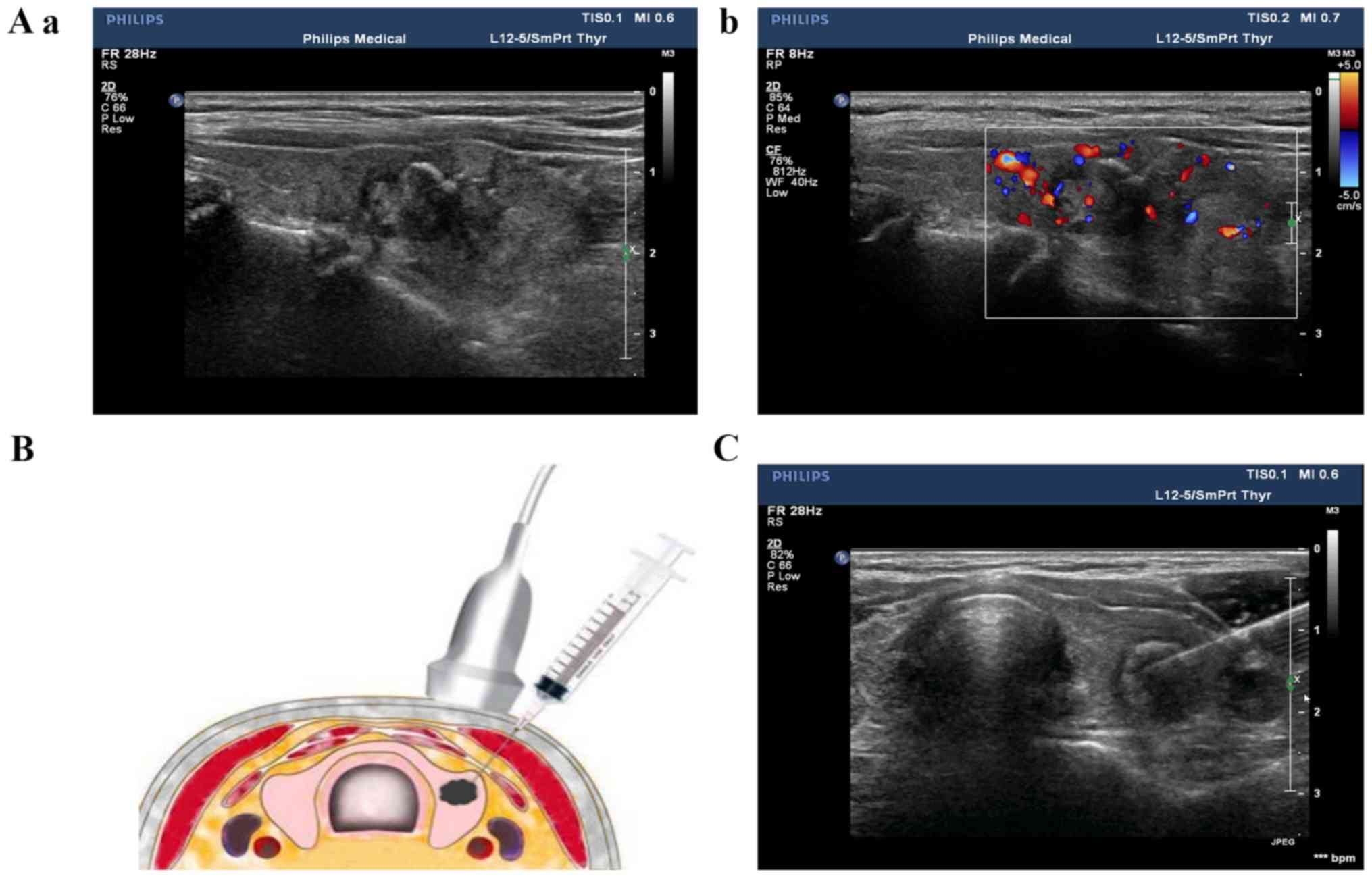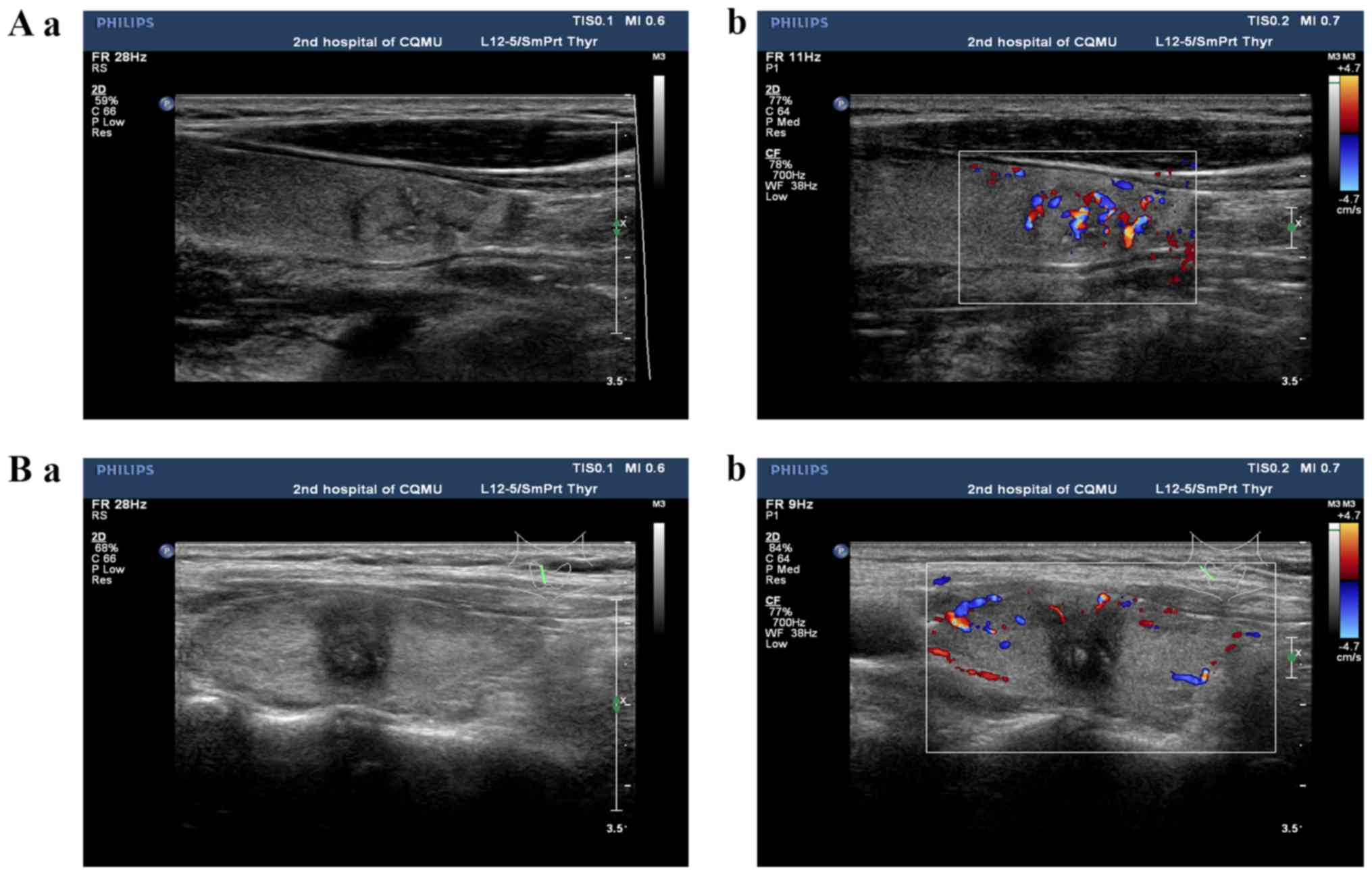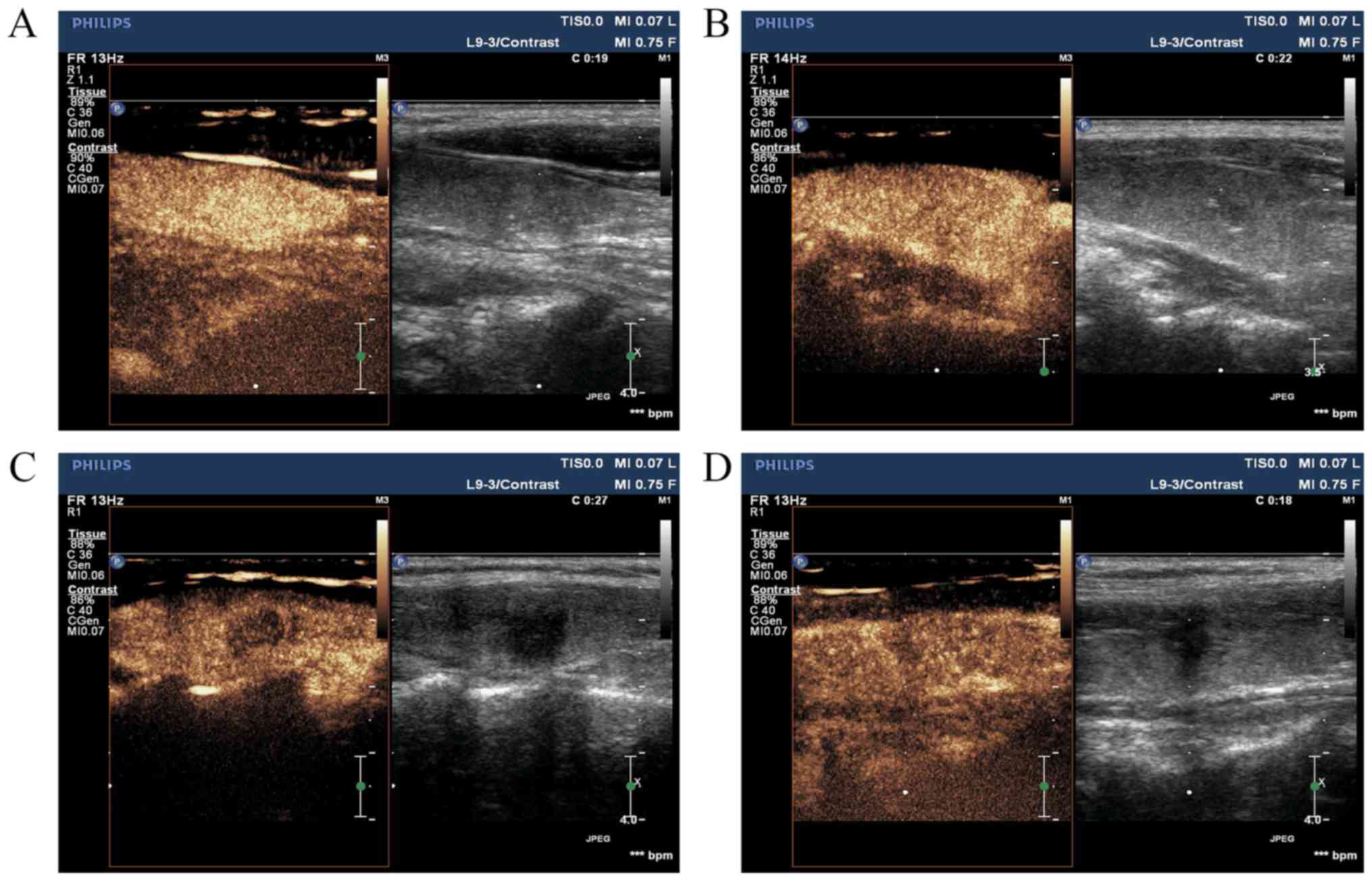|
1
|
Du L, Li R, Ge M, Wang Y, Li H, Chen W and
He J: Incidence and mortality of thyroid cancer in China,
2008–2012. Chin J Cancer Res. 31:144–151. 2019. View Article : Google Scholar : PubMed/NCBI
|
|
2
|
Jung CK, Little MP, Lubin JH, Brenner AV,
Wells SA Jr, Sigurdson AJ and Nikiforov YE: The increase in thyroid
cancer incidence during the last four decades is accompanied by a
high frequency of BRAF mutations and a sharp increase in RAS
mutations. J Clin Endocrinol Metab. 99:E276–E285. 2014. View Article : Google Scholar : PubMed/NCBI
|
|
3
|
Czarniecka A, Oczko-Wojciechowska M and
Barczyński M: BRAF V600E mutation in prognostication of papillary
thyroid cancer (PTC) recurrence. Gland Surg. 5:495–505. 2016.
View Article : Google Scholar : PubMed/NCBI
|
|
4
|
Li F, Chen G, Sheng C, Gusdon AM, Huang Y,
Lv Z, Xu H, Xing M and Qu S: BRAFV600E mutation in papillary
thyroid microcarcinoma: A meta-analysis. Endocr Relat Cancer.
22:159–168. 2015. View Article : Google Scholar : PubMed/NCBI
|
|
5
|
Czarniecka A, Kowal M, Rusinek D,
Krajewska J, Jarzab M, Stobiecka E, Chmielik E, Zembala-Nozynska E,
Poltorak S, Sacher A, et al: The risk of relapse in papillary
thyroid cancer (PTC) in the context of BRAFV600E mutation status
and other prognostic factors. PLoS One. 10:e01328212015. View Article : Google Scholar : PubMed/NCBI
|
|
6
|
Chen Y, Sadow PM, Suh H, Lee KE, Choi JY,
Suh YJ, Wang TS and Lubitz CC: BRAF(V600E) is correlated with
recurrence of papillary thyroid microcarcinoma: A systematic
review, Multi-institutional primary data analysis, and
meta-analysis. Thyroid. 26:248–255. 2016. View Article : Google Scholar : PubMed/NCBI
|
|
7
|
Haugen BR, Alexander EK, Bible KC, Doherty
GM, Mandel SJ, Nikiforov YE, Pacini F, Randolph GW, Sawka AM,
Schlumberger M, et al: 2015 American thyroid association management
guidelines for adult patients with thyroid nodules and
differentiated thyroid cancer: The American thyroid association
guidelines task force on thyroid nodules and differentiated thyroid
cancer. Thyroid. 26:1–133. 2016. View Article : Google Scholar : PubMed/NCBI
|
|
8
|
Livak KJ and Schmittgen TD: Analysis of
relative gene expression data using real-time quantitative PCR and
the 2(-Delta Delta C(T)) method. Methods. 25:402–408. 2001.
View Article : Google Scholar : PubMed/NCBI
|
|
9
|
Brito JP, Ito Y, Miyauchi A and Tuttle RM:
A clinical framework to facilitate risk stratification when
considering an active surveillance alternative to immediate biopsy
and surgery in papillary microcarcinoma. Thyroid. 26:144–149. 2016.
View Article : Google Scholar : PubMed/NCBI
|
|
10
|
Xing M, Alzahrani AS, Carson KA, Viola D,
Elisei R, Bendlova B, Yip L, Mian C, Vianello F, Tuttle RM, et al:
Association between BRAF V600E mutation and mortality in patients
with papillary thyroid cancer. JAMA. 309:1493–1501. 2013.
View Article : Google Scholar : PubMed/NCBI
|
|
11
|
Prescott JD: BRAF V600E status adds
incremental value to current risk classification systems in
predicting papillary thyroid carcinoma recurrence. Surgery.
152:984–990. 2012. View Article : Google Scholar : PubMed/NCBI
|
|
12
|
Zheng X, Wei S, Han Y, Li Y, Yu Y, Yun X,
Ren X and Gao M: Papillary microcarcinoma of the thyroid: Clinical
characteristics and BRAF(V600E) mutational status of 977 cases. Ann
Surg Oncol. 20:2266–2273. 2013. View Article : Google Scholar : PubMed/NCBI
|
|
13
|
Walczyk A, Kowalska A, Kowalik A, Sygut J,
Wypiórkiewicz E, Chodurska R, Pięciak L and Góźdź S: The
BRAF(V600E) mutation in papillary thyroid microcarcinoma: Does the
mutation have an impact on clinical outcome. Clin Endocrinol (Oxf).
80:899–904. 2014. View Article : Google Scholar : PubMed/NCBI
|
|
14
|
Moon HJ, Kim EK, Chung WY, Shin DY and
Kwak JY: BRAF mutation in fine needle aspiration specimens as a
potential predictor for persistence/recurrence in patients with
classical papillary thyroid carcinoma larger than 10 mm at a BRAF
mutation prevalent area. Head Neck. 37:1432–1438. 2015. View Article : Google Scholar : PubMed/NCBI
|
|
15
|
Peyssonnaux C and Eychène A: The
Raf/MEK/ERK pathway: New concepts of activation. Biol Cell.
93:53–62. 2001. View Article : Google Scholar : PubMed/NCBI
|
|
16
|
Liu C, Chen T and Liu Z: Associations
between BRAF(V600E) and prognostic factors and poor outcomes in
papillary thyroid carcinoma: A meta-analysis. World J Surg Oncol.
14:2412016. View Article : Google Scholar : PubMed/NCBI
|
|
17
|
Zhang B, Jiang YX, Dai Q, et al:
Prospective observation of contrast-enhanced patterns of thyroid
nodules with SonoVue. Chin J Med Imaging Technol. 26:844–847.
2010.
|
|
18
|
Yang YJ, Jian-Min L and Wang BC: Study of
relationship between VEGF expression and tumor progress of primary
hepatocellular carcinoma. China J Modern Med. 15:408–412. 2005.
|
|
19
|
Bartolotta TV, Midiri M, Galia M, Runza G,
Attard M, Savoia G, Lagalla R and Cardinale AE: Qualitative and
quantitative evaluation of solitary thyroid nodules with
contrast-enhanced ultrasound: Initial results. Eur Radiol.
16:2234–2241. 2006. View Article : Google Scholar : PubMed/NCBI
|
|
20
|
Zhou Q, Jiang J, Du XP, et al: Value of
contrast-enhanced ultrasound in diagnosis of thyroid papillary
carcinoma. Chin J Ultrasound Med. 27:595–597. 2011.
|
|
21
|
Claudon M, Cosgrove D, Albrecht T, Bolondi
L, Bosio M, Calliada F, Correas JM, Darge K, Dietrich C, D'Onofrio
M, et al: Guidelines and good clinical practice recommendations for
contrast enhanced ultrasound (CEUS)-update 2008. Ultraschall Med.
29:28–44. 2008. View Article : Google Scholar : PubMed/NCBI
|
|
22
|
Cong X, Zhao S, Wang Y, et al: Ultrasound
features of braf t1799a gene mutation papillary thyroid carcinoma.
Med J Qilu. 29:201–212. 2014.
|
|
23
|
Kabaker AS, Tublin ME, Nikiforov YE,
Armstrong MJ, Hodak SP, Stang MT, McCoy KL, Carty SE and Yip L:
Suspicious ultrasound characteristics predict BRAF V600E-positive
papillary thyroid carcinoma. Thyroid. 22:585–589. 2012. View Article : Google Scholar : PubMed/NCBI
|
|
24
|
Sastre-Marcos J, Val-Zaballos FD,
Cortes-Muñoz C, Campos-Martin Y, Aso-Manso S, Jaen-Diaz I,
Vicente-Delgado A and Lopez-Lopez J: BRAF V600E positive papillary
thyroid carcinoma is associated with suspicious ultrasound feature.
Endocrine. 37:EP8502015.
|
|
25
|
Luo ZY, Hong YR, Wen Q, et al:
Associations of the BRAF V600E mutation with sonographic features
in patients with papillary thyroid carcinoma. Chin J Ultrasonogr.
25:785–789. 2016.
|
|
26
|
Li Q, Yuan J, Wang Y and Zhai Y:
Association between the BRAF V600E mutation and ultrasound features
of the thyroid in thyroid papillary carcinoma. Oncol Lett.
14:1439–1444. 2017. View Article : Google Scholar : PubMed/NCBI
|
|
27
|
Moon HJ, Kim EK, Yoon JH and Kwak JY:
Clinical implication of elastography as a prognostic factor of
papillary thyroid microcarcinoma. Ann Surg Oncol. 19:2279–2287.
2012. View Article : Google Scholar : PubMed/NCBI
|
|
28
|
Jin ZQ, Lin MY, Hu WH, Li WY and Bai SJ:
Gray-Scale ultrasonography combined with elastography imaging for
the evaluation of papillary thyroid microcarcinoma: As a prognostic
clinicopathology factor. Ultrasound Med Biol. 40:1769–1777. 2014.
View Article : Google Scholar : PubMed/NCBI
|

















